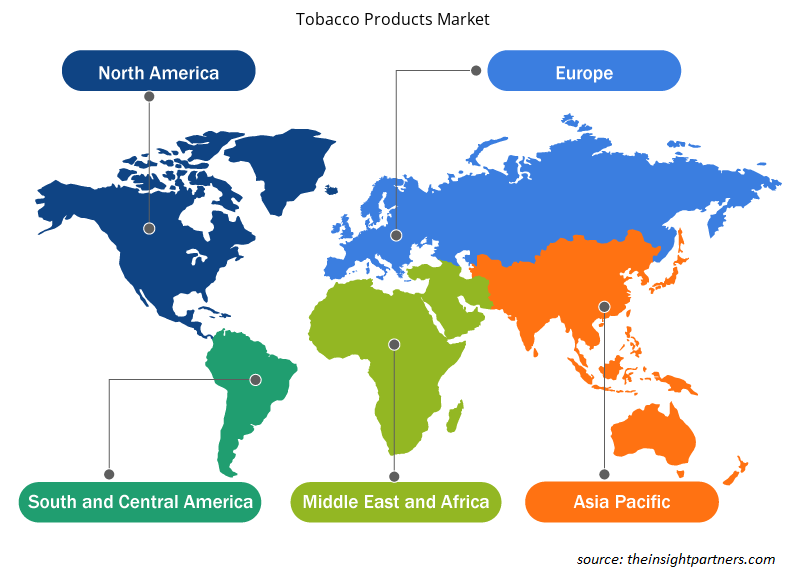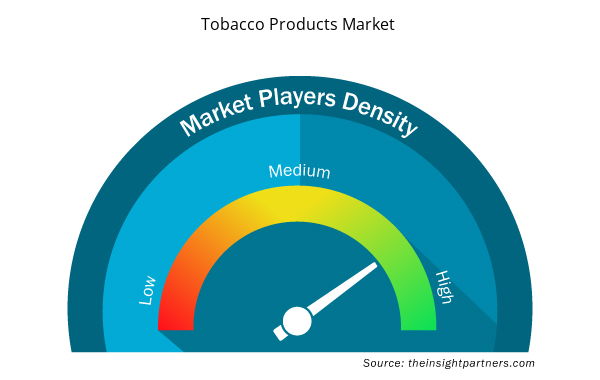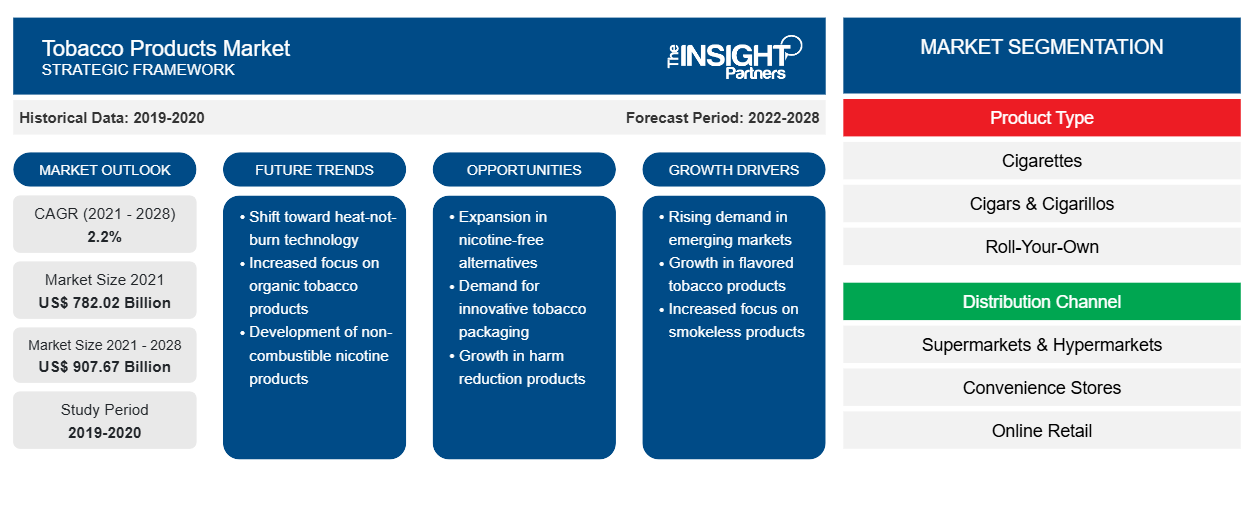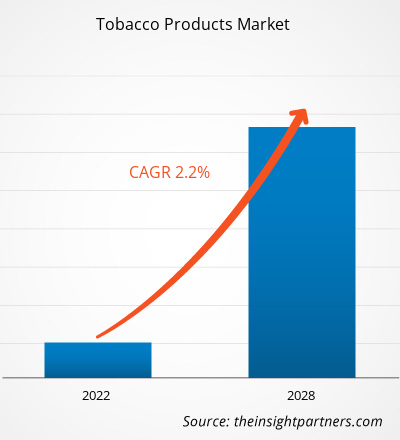담배 제품 시장은 2021년 782,022.19백만 달러에서 2028년까지 907,665.43백만 달러로 성장할 것으로 예상됩니다 . 2021년부터 2028년까지 연평균 성장률 2.2%로 성장할 것으로 예상됩니다.
버지니아와 버리 와 같은 다양한 종류의 담배 잎은 담배 , 시가 및 시가릴로, 롤 담배 와 같은 제품을 제조하는 데 혼합됩니다 . 주식 시장과 압류의 폭락, 그리고 많은 사람들이 흡연을 통해 피난처를 찾게 된 해고와 관련된 스트레스로 인해 경기 침체 기간 동안 담배와 관련 제품의 소비가 전 세계적으로 증가했습니다. 담배는 세계에서 가장 흔히 사용되는 중독성 물질 중 하나입니다. 또한 선진국과 개발도상국의 다양한 국가의 세수입 대부분에 기여합니다.
아시아 태평양 지역은 2020년 담배 제품 시장 에서 가장 큰 점유율을 차지했고 , 중동 및 아프리카는 예측 기간 동안 시장에서 상당한 CAGR을 기록할 것으로 예상됩니다 . 담배 제품 시장에서 활동하는 주요 업체는 잠재적인 고객 기반, 유리한 법률, 지역 전체에서 빠르게 발전하는 소매 환경으로 인해 중동 및 아프리카 전역에서 사업을 확장하고 있습니다.
귀하의 요구 사항에 맞게 이 보고서를 사용자 정의하세요
이 보고서의 일부 또는 국가 수준 분석, Excel 데이터 팩을 포함하여 모든 보고서에 대한 사용자 정의를 무료로 받을 수 있으며 신생 기업 및 대학을 위한 훌륭한 혜택과 할인 혜택을 이용할 수 있습니다.
- 이 보고서의 주요 시장 동향을 알아보세요.이 무료 샘플에는 시장 동향부터 추정 및 예측까지 다양한 데이터 분석이 포함됩니다.
COVID-19 팬데믹이 담배 제품 시장에 미치는 영향
COVID-19 팬데믹은 2020년 초 많은 분야에 전례 없는 어려움을 가져왔습니다. 봉쇄 , 국경 제한, 여행 금지, 제조 중단 및 WHO와 국가 보건부의 지침에 따라 정부가 도입한 기타 안전 조치로 인해 제조 운영이 방해를 받았습니다. 반면, 미국 내과의사 협회가 실시한 연구에 따르면 COVID-19 팬데믹의 첫 16개월 동안 미국에서 담배 판매가 예상보다 많았습니다. 대부분의 담배 회사는 팬데믹 동안 무연 또는 가열 담배 제품과 씹는 담배 제품에 대한 수요가 급증했습니다. 그러나 여행 금지로 인해 소매 여행 판매가 약간 감소했습니다.
시장 통찰력
불연성 담배 제품에 대한 수요 급증으로 시장 성장이 촉진됩니다.
가연성 담배 제품 소비와 관련된 건강 문제가 증가함에 따라 정부는 회사에 담배 소비를 억제하기 위해 여러 법률과 규정을 도입하도록 권장했습니다. 정부는 가연성 담배 세금을 인상하고 불연성 담배 가격을 인하했습니다. 이로 인해 전자 담배와 같은 불연성 제품의 사용이 증가했습니다. 예를 들어, 영국 정부는 가연성 담배 제품에 대한 세금을 크게 인상하고 불연성 제품에 대한 세금을 인하하여 전체적인 접근 방식을 채택했습니다. 이를 통해 영국 시장에서 전자 담배 채택이 증가하여 해당 국가의 흡연 유병률이 크게 감소했습니다. 제조업체는 또한 저위험 제품( RRP ) 범주에 따라 경구용, 불연성 또는 무연성 담배 제품을 개발했습니다.
제품 유형 통찰력
제품 유형에 따라 담배 제품 시장은 담배, 시가 및 시가릴로, 롤 유어 오운, 기타로 세분화됩니다. 다른 담배 제품 세그먼트는 예측 기간 동안 가장 높은 CAGR을 기록할 것으로 예상됩니다. 이 세그먼트에는 전자 담배, 베이프, 스누스, 용해형이 포함됩니다. 가연성 담배 제품으로 인한 피해에 대한 인식이 높아짐에 따라 전자 담배, 베이프, 씹는 담배 제품과 같은 불연성 담배 제품에 대한 수요가 증가하고 있습니다.
유통 채널 통찰력
유통 채널을 기준으로 담배 제품 시장은 슈퍼마켓 및 하이퍼마켓, 편의점, 온라인 소매 등으로 세분화되었습니다. 온라인 소매 부문은 예측 기간 동안 시장에서 가장 높은 CAGR을 기록할 것으로 예상됩니다. 온라인 소매는 사용자에게 편리한 쇼핑 경험을 제공하고, 그 다음으로 간소화된 제품 배송이 뒤따릅니다. 온라인 소매점은 광범위한 제품을 엄청난 할인으로 제공합니다. 또한 소비자는 원하는 제품을 원격으로 편리하게 구매할 수 있습니다. 택배 서비스는 많은 소비자가 전자 상거래 포털을 통해 쇼핑하도록 장려합니다.
담배 제품 시장에서 활동하는 주요 기업으로는 Altria Group, Inc.; British American Tobacco plc; Swedish Match AB; ITC Ltd.; Japan Tobacco International; Imperial Brands; Philip Morris Products SA; Vector Group LTD.; Pyxus International, Inc.; 및 China Tobacco International (HK) Company Limited가 있습니다. 이러한 기업은 규제 프레임워크를 준수하는 것과 함께 새로운 소비자 트렌드를 충족하기 위해 건강 위험이 감소된 제품을 개발하는 데 참여하고 있습니다. 이들은 시장 점유율을 확대하기 위해 합병 및 인수, 사업 확장 및 파트너십에 참여하고 있습니다.
담배 제품 시장 지역 통찰력
Insight Partners의 분석가들은 예측 기간 동안 담배 제품 시장에 영향을 미치는 지역적 추세와 요인을 철저히 설명했습니다. 이 섹션에서는 북미, 유럽, 아시아 태평양, 중동 및 아프리카, 남미 및 중미의 담배 제품 시장 세그먼트와 지리에 대해서도 설명합니다.

- 담배 제품 시장에 대한 지역별 특정 데이터 얻기
담배 제품 시장 보고서 범위
| 보고서 속성 | 세부 |
|---|---|
| 2021년 시장 규모 | 7820억 2천만 달러 |
| 2028년까지 시장 규모 | 9,076억 7,000만 달러 |
| 글로벌 CAGR (2021-2028) | 2.2% |
| 역사적 데이터 | 2019-2020 |
| 예측 기간 | 2022-2028 |
| 다루는 세그먼트 | 제품 유형별
|
| 포함된 지역 및 국가 | 북아메리카
|
| 시장 선도 기업 및 주요 회사 프로필 |
|
담배 제품 시장 참여자 밀도: 비즈니스 역학에 미치는 영향 이해
담배 제품 시장 시장은 소비자 선호도의 변화, 기술 발전, 제품의 이점에 대한 인식 증가와 같은 요인으로 인해 최종 사용자 수요가 증가함에 따라 빠르게 성장하고 있습니다. 수요가 증가함에 따라 기업은 제품을 확장하고, 소비자의 요구를 충족하기 위해 혁신하고, 새로운 트렌드를 활용하여 시장 성장을 더욱 촉진하고 있습니다.
시장 참여자 밀도는 특정 시장이나 산업 내에서 운영되는 회사나 기업의 분포를 말합니다. 주어진 시장 공간에 얼마나 많은 경쟁자(시장 참여자)가 존재하는지 그 규모나 전체 시장 가치에 비해 나타냅니다.
담배 제품 시장에서 운영되는 주요 회사는 다음과 같습니다.
- 알트리아 그룹 주식회사
- 브리티시 아메리칸 토바코 주식회사
- 스웨덴 매치 AB
- 주식회사 ITC
- 일본 담배 국제
면책 조항 : 위에 나열된 회사는 어떤 특별한 순서에 따라 순위가 매겨지지 않았습니다.

- 담배 제품 시장의 주요 주요 업체 개요를 알아보세요
스포트라이트 보고서
- 담배 제품 시장의 진보적인 산업 동향은 플레이어가 효과적인 장기 전략을 개발하는 데 도움이 됩니다.
- 선진 및 개발도상 시장에서 성장을 확보하기 위해 채택된 사업 성장 전략
- 2019년부터 2028년까지 담배제품 시장에 대한 정량적 분석
- 담배 제품에 대한 세계 수요 추산
- 산업에서 운영되는 구매자와 공급자의 효율성을 설명하기 위한 포터의 5가지 힘 분석
- 경쟁 시장 시나리오를 이해하기 위한 최근 개발
- 담배 제품 시장 성장을 지배하는 요인과 함께 시장 동향 및 전망
- 상업적 관심을 뒷받침하는 시장 전략을 강조하여 의사 결정 프로세스를 지원하고 시장 성장을 이끕니다.
- 다양한 노드에서의 담배제품 시장 규모
- 시장의 자세한 개요 및 세분화, 담배 산업 역학
- 성장 기회가 유망한 다양한 지역의 성장 규모
- 역사적 분석(2년), 기준 연도, CAGR을 포함한 예측(7년)
- PEST 및 SWOT 분석
- 시장 규모 가치/양 - 글로벌, 지역, 국가
- 산업 및 경쟁 환경
- Excel 데이터 세트


- Explosion-Proof Equipment Market
- Sweet Potato Market
- Hydrogen Storage Alloys Market
- Ceramic Injection Molding Market
- Cut Flowers Market
- Industrial Valves Market
- Emergency Department Information System (EDIS) Market
- Health Economics and Outcome Research (HEOR) Services Market
- Occupational Health Market
- Energy Recovery Ventilator Market

Report Coverage
Revenue forecast, Company Analysis, Industry landscape, Growth factors, and Trends

Segment Covered
This text is related
to segments covered.

Regional Scope
North America, Europe, Asia Pacific, Middle East & Africa, South & Central America

Country Scope
This text is related
to country scope.
자주 묻는 질문
The global tobacco products market is primarily driven by the rising consumption of tobacco products in developing regions such as Asia-Pacific and the Middle East & Africa.
Based on product type, the other tobacco products segment is projected to grow at the fastest CAGR. Other tobacco products include e-cigarettes & vapes, snus, dissolvable, among others. The growing awareness about the hazardous effects of smoking among consumers is driving the demand for e-cigarettes, vapes, and snus.
Based on distribution channel, the supermarkets and hypermarkets segment held the largest market share owing to high customer traffic in these stores coupled with availability of different brands of tobacco products under one roof.
In 2020, Asia-Pacific led the global tobacco products market owing to the rising number of tobacco consumers across India, China, Japan, among other countries, changing lifestyles of people, increasing disposable income level, and easy available of different brands of tobacco products in the region
The tobacco products market is highly regulated. The manufacturers of tobacco products have to comply with stringent packaging and labeling regulations set by various regulatory bodies across different countries. Moreover, there are few yet dominant market players having strong distribution network and well-established customer base. Further, governments of different nations impose high duties on tobacco products to minimize their consumption. These are some of the entry barriers in the market.
Some of the prominent players operating in the global tobacco products market include Altria Group, Inc.; British American Tobacco plc; Swedish Match AB; ITC Ltd.; Japan Tobacco International; Imperial Brands; Philip Morris Products S.A.; Vector Group LTD.; Pyxus International, Inc.; and China Tobacco International (HK) Company Limited.
Trends and growth analysis reports related to Consumer Goods : READ MORE..
The List of Companies - Tobacco Products Market
- Altria Group, Inc.
- British American Tobacco plc.
- Swedish Match AB
- ITC Ltd.
- Japan Tobacco International
- Imperial Brands
- Philip Morris Products S.A.
- Vector Group LTD.
- Pyxus International, Inc.
- China Tobacco International (HK) Company Limited
The Insight Partners performs research in 4 major stages: Data Collection & Secondary Research, Primary Research, Data Analysis and Data Triangulation & Final Review.
- Data Collection and Secondary Research:
As a market research and consulting firm operating from a decade, we have published and advised several client across the globe. First step for any study will start with an assessment of currently available data and insights from existing reports. Further, historical and current market information is collected from Investor Presentations, Annual Reports, SEC Filings, etc., and other information related to company’s performance and market positioning are gathered from Paid Databases (Factiva, Hoovers, and Reuters) and various other publications available in public domain.
Several associations trade associates, technical forums, institutes, societies and organization are accessed to gain technical as well as market related insights through their publications such as research papers, blogs and press releases related to the studies are referred to get cues about the market. Further, white papers, journals, magazines, and other news articles published in last 3 years are scrutinized and analyzed to understand the current market trends.
- Primary Research:
The primarily interview analysis comprise of data obtained from industry participants interview and answers to survey questions gathered by in-house primary team.
For primary research, interviews are conducted with industry experts/CEOs/Marketing Managers/VPs/Subject Matter Experts from both demand and supply side to get a 360-degree view of the market. The primary team conducts several interviews based on the complexity of the markets to understand the various market trends and dynamics which makes research more credible and precise.
A typical research interview fulfils the following functions:
- Provides first-hand information on the market size, market trends, growth trends, competitive landscape, and outlook
- Validates and strengthens in-house secondary research findings
- Develops the analysis team’s expertise and market understanding
Primary research involves email interactions and telephone interviews for each market, category, segment, and sub-segment across geographies. The participants who typically take part in such a process include, but are not limited to:
- Industry participants: VPs, business development managers, market intelligence managers and national sales managers
- Outside experts: Valuation experts, research analysts and key opinion leaders specializing in the electronics and semiconductor industry.
Below is the breakup of our primary respondents by company, designation, and region:

Once we receive the confirmation from primary research sources or primary respondents, we finalize the base year market estimation and forecast the data as per the macroeconomic and microeconomic factors assessed during data collection.
- Data Analysis:
Once data is validated through both secondary as well as primary respondents, we finalize the market estimations by hypothesis formulation and factor analysis at regional and country level.
- Macro-Economic Factor Analysis:
We analyse macroeconomic indicators such the gross domestic product (GDP), increase in the demand for goods and services across industries, technological advancement, regional economic growth, governmental policies, the influence of COVID-19, PEST analysis, and other aspects. This analysis aids in setting benchmarks for various nations/regions and approximating market splits. Additionally, the general trend of the aforementioned components aid in determining the market's development possibilities.
- Country Level Data:
Various factors that are especially aligned to the country are taken into account to determine the market size for a certain area and country, including the presence of vendors, such as headquarters and offices, the country's GDP, demand patterns, and industry growth. To comprehend the market dynamics for the nation, a number of growth variables, inhibitors, application areas, and current market trends are researched. The aforementioned elements aid in determining the country's overall market's growth potential.
- Company Profile:
The “Table of Contents” is formulated by listing and analyzing more than 25 - 30 companies operating in the market ecosystem across geographies. However, we profile only 10 companies as a standard practice in our syndicate reports. These 10 companies comprise leading, emerging, and regional players. Nonetheless, our analysis is not restricted to the 10 listed companies, we also analyze other companies present in the market to develop a holistic view and understand the prevailing trends. The “Company Profiles” section in the report covers key facts, business description, products & services, financial information, SWOT analysis, and key developments. The financial information presented is extracted from the annual reports and official documents of the publicly listed companies. Upon collecting the information for the sections of respective companies, we verify them via various primary sources and then compile the data in respective company profiles. The company level information helps us in deriving the base number as well as in forecasting the market size.
- Developing Base Number:
Aggregation of sales statistics (2020-2022) and macro-economic factor, and other secondary and primary research insights are utilized to arrive at base number and related market shares for 2022. The data gaps are identified in this step and relevant market data is analyzed, collected from paid primary interviews or databases. On finalizing the base year market size, forecasts are developed on the basis of macro-economic, industry and market growth factors and company level analysis.
- Data Triangulation and Final Review:
The market findings and base year market size calculations are validated from supply as well as demand side. Demand side validations are based on macro-economic factor analysis and benchmarks for respective regions and countries. In case of supply side validations, revenues of major companies are estimated (in case not available) based on industry benchmark, approximate number of employees, product portfolio, and primary interviews revenues are gathered. Further revenue from target product/service segment is assessed to avoid overshooting of market statistics. In case of heavy deviations between supply and demand side values, all thes steps are repeated to achieve synchronization.
We follow an iterative model, wherein we share our research findings with Subject Matter Experts (SME’s) and Key Opinion Leaders (KOLs) until consensus view of the market is not formulated – this model negates any drastic deviation in the opinions of experts. Only validated and universally acceptable research findings are quoted in our reports.
We have important check points that we use to validate our research findings – which we call – data triangulation, where we validate the information, we generate from secondary sources with primary interviews and then we re-validate with our internal data bases and Subject matter experts. This comprehensive model enables us to deliver high quality, reliable data in shortest possible time.


 이 보고서에 대한 무료 샘플을 받으세요
이 보고서에 대한 무료 샘플을 받으세요